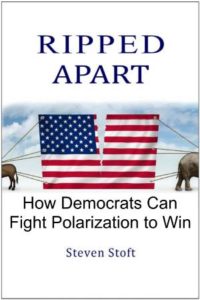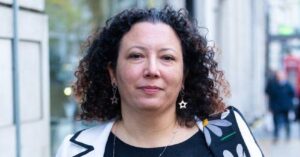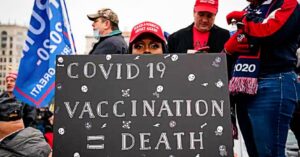5.1 Socialism, Liberalism and All That
I am against private socialism of concentrated private power as thoroughly as I am against governmental socialism. The one is equally as dangerous as the other.
—Franklin Delano Roosevelt, March 12, 1935
Only one presidential candidate that I know of has ever adopted his own political label and given a speech defining it. That label, of course, is “democratic socialist,” an old label but one which Bernie Sanders gave his own personal meaning to in 2015 and again in 2019.
You might think he was trying to clarify “democratic socialism” for his followers. Quite the contrary. The definition he gave left many (and in my experience, most) of his followers unable to answer the two most obvious questions about real democratic socialism:
- Is it a kind of socialism? (Yes)
- Is it a kind of capitalism? (No)
Confusingly the answers are just the reverse, if we are talking about Sander’s new sanitized “democratic socialism” — what he tells his followers, not what he believes himself. And his followers are just as confused about Sander’s definition as they are about the real definition.
I tried asking some among his army of texters whether Sanders was a “democratic socialist” or a “socialist” and found that Sanders’ campaign had supplied them with a pre-approved message that dodged the question, and none would answer in their own words. When I pushed two of them, one guessed Sanders was a capitalist and the other guessed, not a capitalist. Neither had heard what Sanders thought about this.
Why would Sanders make such a big deal out of this label and not clear up such obvious questions? Clearly, he has a hidden agenda. But what is it?
Sanders’ hidden agenda. In this chapter and the next, I’ll argue that Sanders has spent his political life in the socialist lane, which has no track record of success. For credibility, he needs to move out of it but cannot abandon his lifelong “socialist” label. So he tweaked his label to a less familiar one, “democratic socialist,” and redefined this to be the same as FDR liberalism. So now he pretends that FDR was a socialist and that he, Sanders, is the new FDR.
This is a deplorable misrepresentation of both FDR and Sanders himself, but the damage to the party comes from the deceptions he has perpetrated on his followers. The result is that Berniecrats now believe liberals reject FDR’s political agenda.
Berniecrats believe: Today’s liberals reject FDR’s political agenda because FDR was a democratic socialist.
And so they see liberals as either conservative (neoliberals) or corrupt. Their reasoning is this: Liberals reject democratic socialism, and FDR was a democratic socialist, so liberals reject FDR.
This is nonsense. FDR hated socialism, which already meant democratic socialism back then. Modern liberals are FDR liberals, and they agree with FDR about rejecting socialism, and they support his political agenda. So they agree with Sanders supporters, who as we saw in Chapter 5, are FDR liberals but don’t know it.
This deception continues to do a huge amount of damage to the Democratic Party.
- It causes Berniecrats to hate the half of the party that opposes (real) democratic socialism (e.g. Venezuela).
- It makes it vastly easier for Trump to call the party a bunch of socialists and make it stick.
To discuss all this, we need to untangle Sanders’ definitions of socialism and democratic socialism.
First, What Is Capitalism?
Under capitalism, companies are privately owned, and the owners get the profits. I’ll bet you knew that already. This is why the President of Denmark told Sanders that Denmark was not socialist when Sanders said it was. The Danish economy is driven by companies owned by capitalists, so Denmark has a capitalist economy.
In the early days of capitalism, in the U.S. and elsewhere, some business owners got exceedingly rich while the workers who made all the products worked 60 or even 80 hours a week and received starvation wages. (That still happens to some undocumented immigrants.) In America, most workers are now vastly better off than that, but the inequality remains, and many are still paid unconscionably low wages, give the wealth of this country.
But capitalism does not have to be like that. Capitalism just means businesses are privately owned, the owners decide what to sell and then set prices to make a profit. There is still plenty of room for government regulation and taxes that dramatically reduce inequality and treat workers fairly.
What’s Socialism?
The core idea of socialism is that companies should be socially owned and that no capitalists should be involved and making profits. So the one sure thing about socialism is that it’s not capitalism.
That is why you will never hear Bernie Sanders say he is a capitalist or that he believes we should have some type of capitalist economy.
That is also why Elizabeth Warren has said she is “a capitalist to my bones” and will never say she is a socialist. The whole point of socialism has always been to replace capitalism. There are two kinds of socialism:
- Government-ownership socialism
- Worker-ownership socialism
Bernie Sanders believed in the first kind, government ownership, until he was about 40. In the 1970s, he liked to talk about how utilities and energy companies should be owned by the government, not capitalists. Then he went silent until his 2015 democratic socialism speech when he said, “I don’t believe government should own the means of production.” That’s Marxist jargon for rejecting government-ownership socialism.
Sanders has now switched to worker-ownership socialism. Companies would not be owned by capitalists but, instead, by their workers. The Democratic Socialists of America (DSA) are also fond of this kind of socialism, although they have mixed views.
What’s Real Democratic Socialism?
Both kinds of socialism (governmental and worker ownership) are simply economic systems that can operate under a democracy or a dictatorship. So there is no mystery to democratic socialism. It’s just socialism under a democratic government.
This idea dates back to at least 1900. About the only American socialists who were not democratic socialists (worker-dictatorship socialists), called themselves communists. For the last 120 years, “socialist” has just been a short-version of “democratic socialist.” There is no difference
Some democratic socialists, like Michael Harrington, the founder of DSA, favor government-ownership socialism, while others favor worker-ownership socialism. Sanders started as the first type but seems to have flipped flopped to the second.
What’s Sanders’ “Democratic Socialism”?
Because Sanders wouldn’t make the biggest flip-flop ever, he is still a real democratic socialist, in other words a real socialist who wants socialism under a democracy. But for his followers, he has misdefined democratic socialism to be FDR’s liberalism — a kind of capitalism, not a kind of socialism.
What is FDR Liberalism?
When FDR first ran for president in 1932, he ran on a balanced-budget, small-government platform much like President Hoover’s. But, as explained in Chapter 5, Roosevelt shifted a bit to the left and then captured the “liberal” label from the Hoover conservatives. He also labeled them “conservatives.” Hoover, who had been a leading progressive, was not happy, but his side lost, and the “liberal” and “conservative” labels stuck.
Although “liberal” had, roughly speaking, meant libertarian, Roosevelt redefined it to mean a philosophy of government responsibility for social welfare — the opposite of libertarian.
It’s to the right of socialism. The socialists saw Roosevelt’s liberalism as applying Band-Aids to capitalism to save it from a political revolution leading to socialism. Whenever Norman Thomas, the six-time Socialist presidential candidate, was asked if FDR was carrying out his socialist program, he would answer with one of his famous quips such as, “Yes, he is carrying it out in a coffin.”
And as noted in Chapter 5 and on the DSA website, many historians agree that Roosevelt saved capitalism from socialism at a time when socialism could have been a serious threat. So Roosevelt was far to the right of socialism.
It’s to the right of Huey Long’s populism. We can be even more precise. Huey Long, the famous populist U.S. Senator from Louisiana, was a staunch anti-socialist and openly sought to preserve capitalism. He was clearly to the right of the socialists, yet FDR still considered him dangerous and so far left that he would adopt few of his proposals. So Huey Long was to the right of the socialists, and FDR was to the right of Huey Long.
FDR liberalism is FDR’s New Deal plus his Second Bill of (economic) Rights, plus all kinds of civil rights and environmental protections.
Roosevelt’s liberalism was a new, middle path, one step to the left of Hoover’s conservative, small-government philosophy and two steps to the right of socialism. It included his New Deal policies and his Second Bill of (economic) Rights. But when modern Democrats speak of liberalism, they mean all that plus something else just as important — all kinds of civil rights. And that’s what I mean when I refer to “liberalism.” But just as a reminder, I will often call this combination FDR liberalism.

 Ripped Apart
Ripped Apart

